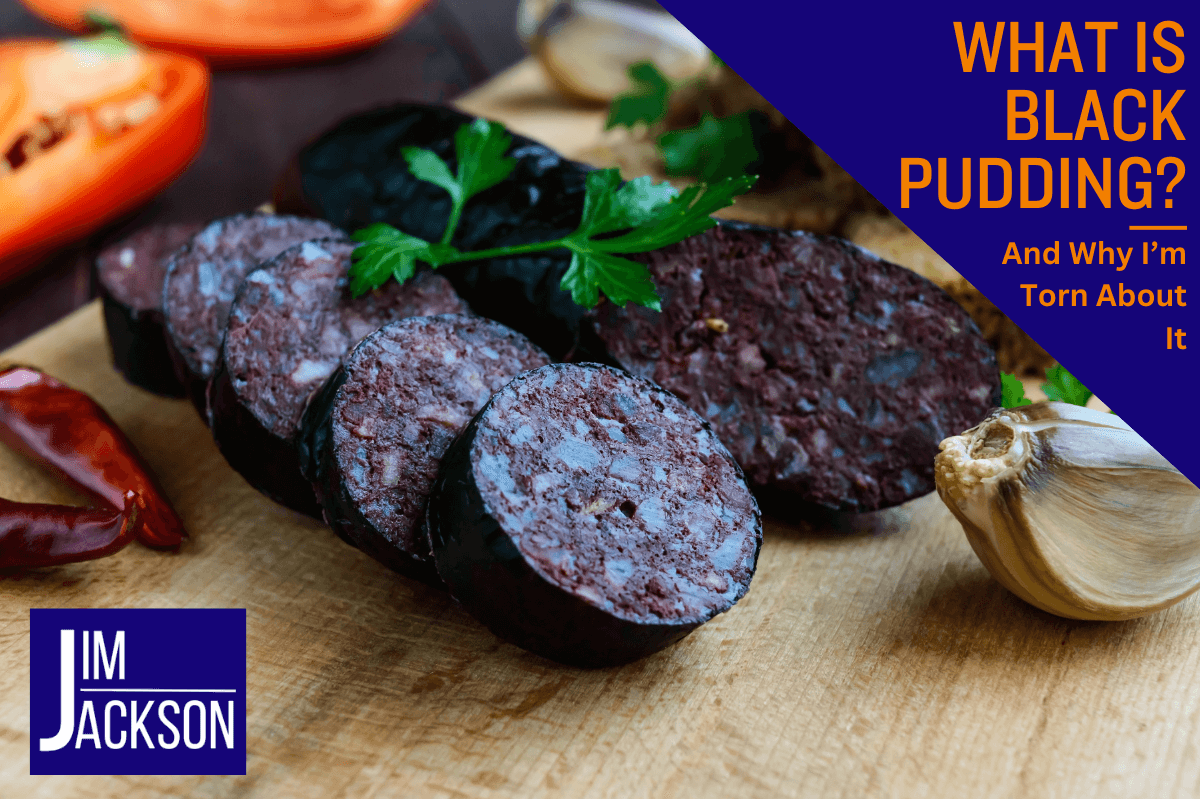What Is Black Pudding? And Why I’m Torn About It
Ask anyone what black pudding is, and you’ll probably get one of two reactions: a scrunched-up nose or the classic, “Is that some kind of gateau?” Similar to sweetbread, black pudding is not a sweet or a pudding.
Growing up in England, black pudding was one of the main features of the English breakfast. Even for us Brits, you either loved or hated it. Me… I loved it, and my breakfast didn’t feel complete without it.
Black pudding is one of those foods that divides opinion faster than pineapple on pizza. Some swear by it as the king of the fry-up, while others can’t get past the idea that it’s made with blood.
Here’s the thing: black pudding has a long history, a strong cultural identity, and surprisingly, some health benefits. But it also contains oats, barley, and other fillers, which don’t align with an animal-based diet like mine.
So, do the pros outweigh the cons? Is it something worth keeping on your plate—or should it stay in history books alongside King Henry VIII’s banquets?
Let’s start with the basics: what is black pudding really?
TL;DR
- Black pudding is a traditional food made from pig blood, pork fat, oats or barley, and seasoning, cooked into tasty slices.
- It has a long history, from blak podyngs in medieval recipes to regional variation like Stornoway black pudding and French boudin noir.
- Health benefits come from the blood and fat, but fillers like pearl barley or wheat clash with an animal-based diet—though gluten-free options exist.
- Black pudding remains part of rich local cuisine, whether grilled in an English breakfast, baked in a Manchester Egg, or fried for a fry-up.
A Quick Definition: What Is Black Pudding?
At its core, black pudding is a type of blood sausage that’s been part of British and Irish cooking for centuries. Traditionally, it’s made using pig blood mixed with pork fat, oatmeal, pearl barley, and a blend of seasoning that varies from butcher to butcher.
The mixture is stuffed into natural casings and either boiled, quickly roasted, baked, grilled, or fried before being served in tasty slices.
So, what is black pudding exactly? Think of it as one of the earliest examples of nose-to-tail eating, where no part of a butchered animal was wasted. Blood and fat provided valuable nutrition a long time ago, and stretching it with oats or barley helped feed families on a budget.
Even today, black pudding recipes remain a staple in local cuisine across the UK and beyond, from a hearty fry-up in Manchester to a plate of Stornoway black pudding in Scotland.
But black pudding isn’t unique to Britain. Many regions around the world make their own blood sausages, from the French boudin noir to Italy’s sweeter sanguinaccio dolce. Each has its own regional variation, with spices that vary and fillers depending on what was locally available.
In modern times, cooked black pudding has become a traditional food icon, often showing up in the classic English breakfast. Whether you see it as a humble sausage or a delicacy worthy of a black pudding festival, it’s one of those foods that sparks debate, curiosity, and, for some of us, a guilty craving.
The Long History of Black Pudding: From King Henry VIII to Today
Black pudding isn’t some trendy invention dreamed up by celebrity chefs. It has been part of the human diet for a very long time, showing up in European food history for over a thousand years.
Early mentions of “blak podyngs” appear in medieval recipes, proving that our ancestors weren’t squeamish about mixing blood, fat, and grain into something hearty and filling.
By the Tudor period, black pudding was well known across England. King Henry VIII is said to have enjoyed feasting on rich meats, puddings, and sausages at his banquets.
Later, even great thinkers like Sir Isaac Newton and theologians of his era weighed in on whether eating blood was acceptable under Christian law. Theological debate and nonreligious support clashed, with some claiming black pudding broke Jewish law, while others insisted Christian exemptions allowed it.
Despite controversy, people kept on making black pudding. When the Great Fire of London destroyed many homes, food like black pudding survived in written recipes and oral tradition.
Its staying power comes from practicality—nothing from a butchered animal went to waste, and fat and blood were too valuable to throw out.
Over time, regional variation developed. Stornoway black pudding in Scotland became famous for its distinct seasoning, while Canadian provinces created their own twists using pork blood or even cow’s blood.
Across Europe, versions like boudin noir in France and sheep’s blood puddings in Eastern Europe show how widespread the idea became.
From medieval kitchens to modern gastropubs, black pudding has proved itself more than just a stomach-stuffed sausage. It’s a traditional food that’s been served for centuries, carrying history, debate, and plenty of recipes along with it.
How Black Pudding Is Made: From Blood to Tasty Slices
Making black pudding might sound off-putting if you focus too much on the “blood” part, but the process is more straightforward than you’d think.
At its simplest, black pudding is a sausage that combines blood, fat, grain, and spices, all held together in natural casings. The result? A hearty, cooked slice that’s stood the test of time.
The Ingredients
The foundation is usually pig blood, though some regional recipes swap in cow’s blood or sheep’s blood. To give the pudding richness and structure, pork fat or beef suet is added, along with oats or barley (sometimes oatmeal or pearl barley).
These fillers stretch the mixture, making it more filling while adding texture. Salt, pepper, and other seasonings are blended in, though spices vary depending on the recipe.
The Process
Once the mixture is ready, it’s carefully spooned into stomach-stuffed or natural casings. Traditionally, this meant using the cleaned stomach of a butchered animal, though modern butchers more often use casings designed for sausages.
Depending on preference, the pudding is then boiled, quickly roasted, baked, grilled, or fried. Once cooked, it’s sliced and served as part of a meal.
Regional Twists
While the core idea stays the same, many recipes exist. In Scotland, Stornoway black pudding is renowned for its balance of fat and blood with oats.
In France, boudin noir is seasoned differently, while Italian sanguinaccio dolce even adds sugar for a dessert-style pudding. This regional variation proves there’s no single way of making black pudding—only a shared tradition of turning blood into tasty slices.
Cooking and Serving Black Pudding
Black pudding is versatile. Once made, it can be boiled, baked, grilled, or fried, and each method changes the texture slightly.
A quickly roasted or, my favorite, pan-fried slice develops a crispy outside with a soft, rich centre, while boiled or baked versions stay softer. No matter the method, it’s usually served in thick, tasty slices.
Classic English Breakfast and Fry Up Culture
For many, black pudding’s claim to fame is its spot in the full English breakfast. Alongside eggs, bacon, sausages, and tomatoes, it adds a deep, savoury note that makes the fry-up legendary.
The English Breakfast Society even highlights traditional black pudding as a key component of this meal, proving its importance to British food culture.
Traditional Black Pudding vs. Other Variations
Black pudding has cousins. White pudding uses pork fat, oats or barley, and seasoning—but without blood.
French boudin noir leans more on spices, while Italian sanguinaccio dolce mixes in sugar for a surprising twist. Each regional variation shows how adaptable the combination of fat and grain can be when blended with different flavours.
Gluten-Free Options
Here’s where I’m torn. Black pudding usually includes oats or barley, which means gluten—a no-go for me most of the time.
Thankfully, some butchers now make gluten-free versions using pork blood, rice, or maize instead. These allow me to indulge in the flavour of cooked black pudding without straying too far from my diet.
Why I’m Torn: Health Benefits vs. Diet Risks
Here’s the honest truth: I love the taste of black pudding. The problem is, it doesn’t always fit neatly with the way I now eat. Let me explain why.
The Benefits of Blood
Blood is nutrient-dense. Pig blood, cow’s blood, or sheep’s blood all carry iron, protein, and B vitamins. Historically, blood was too valuable to waste, which is why it became a core part of many recipes.
Even dried blood has been used in puddings to preserve nutrition. Eating blood sausages like black pudding provided essential nourishment when food was scarce.
The Role of Fat
Black pudding isn’t shy about fat. Pork fat or beef suet gives it that rich taste and satisfying texture. The combination of fat and blood makes it a filling food, and for our ancestors, it was vital fuel.
But here’s the sticking point: modern nutrition debates. Some worry about saturated fats, though common sense suggests we’ve been eating animal fats for millennia without issue.
The Gluten Problem
Now for the part that keeps me on the fence. Most black puddings are bulked out with oats or barley. While this helped stretch ingredients a long time ago, it doesn’t fit my mostly animal-based diet.
Gluten simply isn’t something I want much of. That said, gluten-free black pudding options are appearing, so I occasionally indulge.
For me, black pudding is the perfect example of a traditional food that’s both brilliant and bothersome. I respect its history, value the nutrition in its blood, and admire how nothing from a butchered animal went to waste.
But those fillers? That’s where I hesitate.
If You’re Curious: Related Treats and Recipes
Black pudding doesn’t stand alone. Around the world, you’ll find blood-based puddings and sausages that look familiar but carry their own twist. For the adventurous eater, this opens a door to many recipes worth trying.
Blood Pudding, White Pudding, and Beyond
Blood pudding is essentially another name for black pudding, while white pudding is a close relative that leaves out the blood but keeps pork fat, oats or barley, and seasoning.
Across Europe, boudin noir is a popular version, with spices that vary depending on the region.
Italy takes a completely different approach with sanguinaccio dolce, a dessert in which dried blood is mixed with sugar and chocolate.
Oddities and Regional Variation
Some recipes push boundaries further.
In certain places, lamb’s brains or even stomach-stuffed casings have been used. Canadian provinces still make blood sausages using cow’s blood or pork blood, while Eastern Europe often favours sheep’s blood.
Each regional variation reflects local cuisine, showing how communities found ways to use fat and blood creatively.
Modern Takes and Curiosity Bites
Today, you’ll even find quirky dishes like the Manchester Egg—an egg wrapped in black pudding and sausage meat and deep fried. Recipes like this prove black pudding isn’t just a breakfast food; it’s adaptable, and with many recipes circulating, it continues to inspire cooks worldwide.
From traditional black pudding served with mashed potatoes to international cousins like boudin noir or sanguinaccio dolce, one thing is clear: people everywhere have found a way to make blood delicious.
Final Thoughts: My Flip-Flop on Black Pudding
Black pudding is one of those foods that stirs up equal parts nostalgia and debate. On the one hand, it’s a traditional food that kept families fed a long time ago, cleverly using fat and blood from a butchered animal.
It carries centuries of history, from mentions of blak podyngs in medieval recipes to the theological debate involving Thomas Barlow, future bishop of Lincoln, over whether eating blood broke Jewish law or if Christian exemptions applied.
Even Sir Isaac Newton had opinions on food like this, showing how far back the conversation goes.
On the other hand, my modern diet doesn’t always agree with it. Oats or barley, pearl barley, and wheat fillers don’t fit with my animal-based approach, so I often pass.
Still, I can’t deny the taste. Whether baked into a Manchester Egg or fried crisp for a fry-up, it remains one of the richest flavours in local cuisine.
So where do I land?
It’s not in alignment with my animal-based diet, so I call it a sometimes food. I’ll happily eat a few tasty slices when I stumble on a gluten-free version because, let’s face it, it’s part of the nose-to-tail philosophy that I’m a fan of… plus it tastes damn good.
Love it or hate it, black pudding has earned its place in food history—and maybe, occasionally, on my plate.
And that’s it… have a nutritious day!
FAQs
Why is black pudding illegal in the US?
Black pudding isn’t illegal in the US, but importing fresh pig blood or blood sausages faces restrictions. Some local butchers use pork blood or cow’s blood for regional variation.
What is black pudding made of?
Traditional black pudding is made from pig blood, pork fat or beef suet, oats or barley, pearl barley, seasoning, and natural casings, then boiled, baked, grilled, or fried into tasty slices.
Why do British people eat black pudding?
British people eat black pudding because it’s a traditional food rooted in local cuisine. Recipes using fat and blood date back to blak podyngs, offering nutrition, flavor, and rich cultural history.
What is black pudding called in the USA?
In the USA, black pudding is often called blood pudding or simply blood sausages. Regional variation exists, especially in Canadian provinces and immigrant communities familiar with boudin noir.







